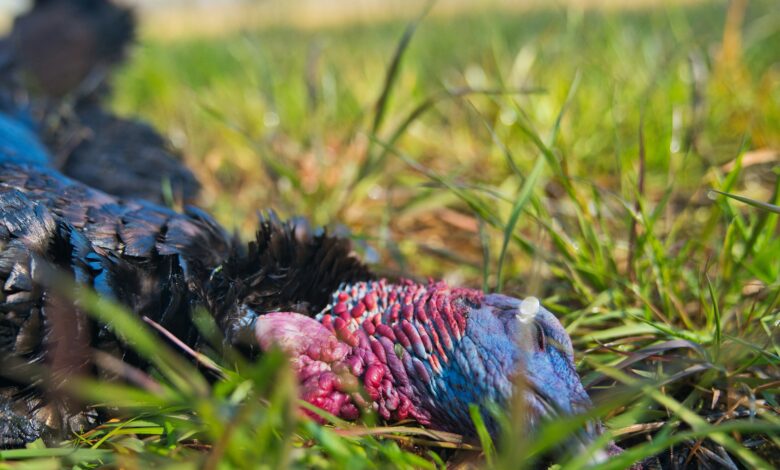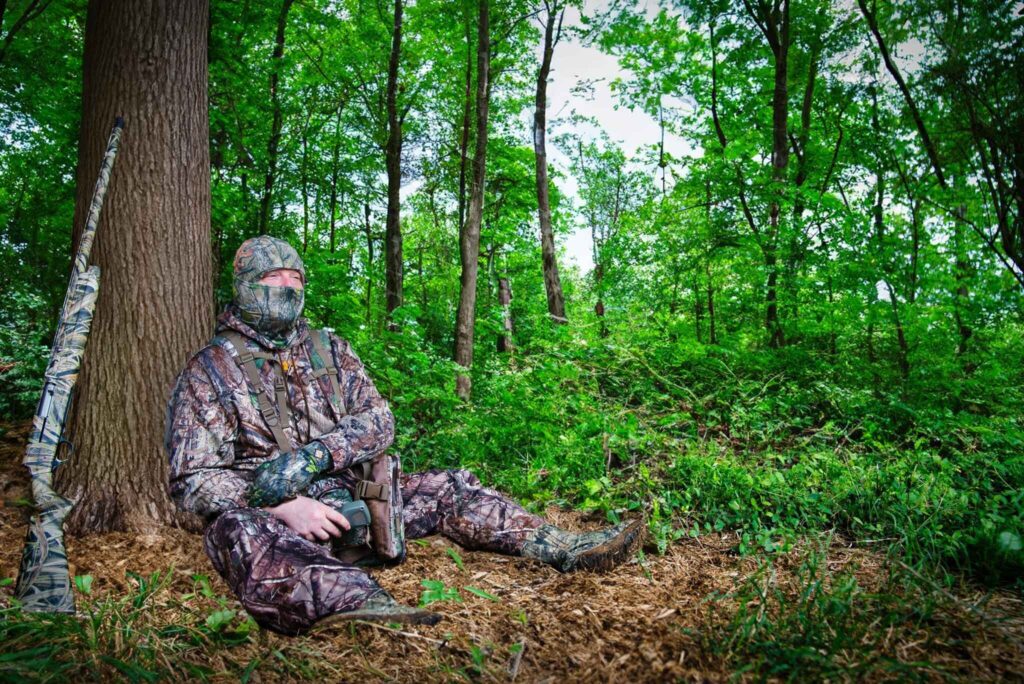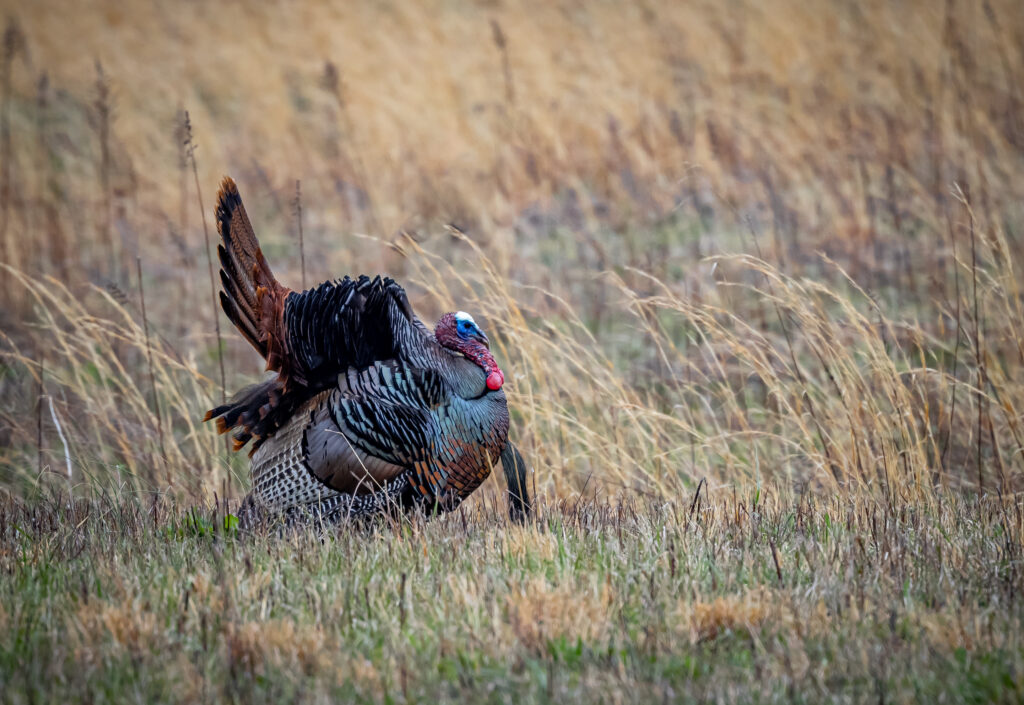Turkey Hunting Essentials: Own The Season’s Expert Breakdown

Planning to go for your first spring turkey hunt?
But even if you know all the turkey hunting tips and tricks, bagging the tom on your first hunt is not easy. At times, the toms can outwit even veteran hunters.
Thankfully, you can increase your chances of success by choosing the right turkey hunting gear. And you don’t need a ton of gear for a successful turkey hunt. The point is to separate the necessary from the luxury and make your first hunt count.
So, let’s take a look at the turkey-hunting essentials with the help of “Own The Seasons” Art and Michelle Helin!
Turkey Hunting Apparel
Turkeys are blessed with incredible vision. So, wearing camo with earth tones to help you blend with the surroundings is a good idea.
It is also important to choose a subtle camo pattern that will work for most seasons. Always make sure to pick rugged and comfortable clothing. Typical military camouflage gear can work, but make sure not to pick vibrant greens. Even better, pick a suit with a leafy pattern that helps you to blend in.
A good turkey vest is another essential piece of the outer shell primarily because of the numerous pockets it has.
These inner and outer pockets are ideal for storing a crazy amount of essential gear. Some vests even have larger pockets to store hydration bladders and rain gear. I prefer using vests that offer a comfortable fit with an adjustable strap system.
It is best to pick a water and wind-resistant material for your outer layer. Remember not to pick a material that makes too much noise when you move around. Make sure to put it on in the store and check how it feels.
Beyond that, here are some other apparels that you may find necessary.
Gloves
Gloves are an essential piece of protection for your hands, especially in prickly environments. Plus, they help to keep your extremities warm when the weather turns cold. Moreover, the less amount of exposed skin you have, the better. The extra camouflage provided by the gloves is an advantage.
The choice of material is between leather and synthetic. I prefer light gloves made from synthetic materials that offer flexibility and tactility. If you do not mind the extra bulk and prefer more warmth, leather is the right choice. For additional comfort in the chilly mornings, you can pick hand warmers.
Face Mask/Gaitors
Even the best-grade camouflaged gear and pants will not work if your face remains uncovered. Manu hunters prefer face paints, but they will not provide protection from cold and can get messy.
A face mask can match your camo clothing and can be removed when needed. That said, you will need a few different patterns for use in different environments.
Having the mask covering your ears can be a problem. Also, for bow hunters, the mask can affect your draw and anchor points, leading to reduced accuracy. So, weigh your options before making a choice. Best pair your face mask with a hat and a neck gaiter to complete the camouflage.
Hunting Boots
Coming to footwear, you need a reliable hunting boot with a breathable, waterproof outer and a cushioned midsole. A durable rubber outsole that sticks to tricky surfaces is a must. In terms of quality, some boots stand above the rest. So picking a top-grade product makes sense.
The secret sauce for selecting the perfect hunting boot is taking note of your hunting style and the terrain.
For rugged terrain, balancing robustness with the weight of the boot is important. If you hunt turkeys in winter, you will need insulated boots for warmth. Lastly, you need to dial in your budget limits to make the final choice.
Turkey Calls
No matter the type of call you choose, make sure to familiarize yourself with it. Not all calls are easy to master and heading to the field without the right amount of practice will not work. Here are the three common types of turkey calls you can pick.
Box Calls
Box calls are great for beginners as they are easy to master and sound realistic. One reason I always carry a box call in my vest pocket is they are great in a quiet environment and even in windy conditions. However, being friction-based, these calls do not work in damp conditions.
Diaphragm Calls
While the learning curve for using a diaphragm call is steeper, it is more versatile and easy to carry in the pocket. Actually, by using a mouth call, you can vary the pitch and tone and make the call sound more natural. On the downside, they are not the loudest and the sound does not carry far.
Custom Friction Calls
Some common materials used for friction calls are glass, slate, ceramic, aluminum, and copper. Each material can generate different calls, ranging from loud to soft and high-pitched.
A slate surface is the most popular option for softer calls and is easy to use. Glass is good for higher-pitched calls but not the best choice for newbies. I prefer using anodized aluminum as it is super versatile and needs minimum maintenance. It can also be used in all weather conditions.

Turkey Decoys and Blinds
Sitting still under a tree for hours can be tough on your rear and back. This is where a ground blind is super helpful, especially when the weather turns foul.
A ground blind allows you to move, and you can even use a chair for more comfort. Besides, if you are carrying camera gear, blinds are perfect for some preseason turkey photography.
I usually set up the blind a few days before the hunt so that the turkeys get used to it. You can conceal them with leaves and branches as well. Remember to check the opening and closing mechanism of the mesh windows. Noisy zippers and Velcro are not the best options.
While hunting from blind, realistic turkey decoys can be a game changer. The decoy styles and poses you need to use will depend on the time of the season.
The last thing you want is the decoy setup acting as a turnoff for a longbeard. Also, the reactions of subordinate gobblers and dominant gobblers will be different for a decoy.
Hard-body decoys can be a pain to carry, but they are more realistic than collapsible options. For newbie hunters, jake decoys with one to three hens placed close to the ground are good options.
Another good option during the early season is using a strutting tom decoy to trap aggressive males. In late season, a single upright hen can be a good option.
Shotguns
Choosing the right shotguns, accessories, and ammunition for turkey hunting can be challenging for beginners. But guess what?
Dialing these variables to perfection is a lot of fun as you gain experience.
The main shotgun options are the 12-gauge, the 20-gauge, and the .410 bore. A barrel length should be between 22-26 inches should be a good choice. In reality, you will need some time to figure out what works best for you.
.410-Bore
Now, a .410 bore with a fixed full choke is not the best choice for aiming at a still target like the head of the turkey in the woods. Not unless you mount a red dot turkey sight. On the plus side, a .410 is super light and the recoil is much less than the other two options.
Obviously, shooting with the smaller .410 bore makes turkey hunting more challenging. Cut, when the tom is within 20 yards, the .410 bore can be deadly in skilled hands.
20-Gauge
The 20 gauge shotgun is heavier, but not by much. The shorter barrels also make moving through the woods easier. I hate shotgun barrels announce my presence by snagging on a low branch with a noisy clank, especially while roosting a turkey.
Plus, the recoil from a 20 gauge is manageable, even for kids and those with less upper body strength. By packing TSS loads you can easily extend your range beyond 40 yards with a 20 gauge.
12-Gauge
The 12 gauge is the most popular choice and you will find more turkey loads for this shotgun. In terms of range, the 12 gauge outperforms the 20 gauge. Moreover, it delivers more downrange energy and higher pellet counts.
That said, a 12 gauge shotgun has more weight and heavier recoil. Withstanding the mule kick of a 31⁄2-inch magnum takes some training. Also, the 12 gauge guns and ammunition are priced higher.
Turkey Loads
Compared to the traditional lead game loads of the old days, modern shotgun loads for turkeys have come a long way. Then came the game changers- the non-toxic tungsten super shots packing solid knockdown power. With so many options available, choosing the best turkey load is no simple task.
Admittedly, you will need some time to wrap your head around the shell nomenclature system. The first thing is, that the shell gauge should match the shotgun gauze.
The shell length can vary between the smaller 2 ½-inches and the larger 3 ½” inches. Then again, the naming system follows an inverse pattern. That means the #4 shot is smaller than the #1 shell. Buckshot for deer hunts come in even larger sizes.
Two common shell materials are lead and tungsten, with tungsten being denser. Both lead and copper-plated lead shells are affordable options that offer good reliability.
The higher density of tungsten allows shell-makers to pack more pellets inside the shell. With tungsten super shots, you get a higher range and better pattern density. However, they are higher priced.
Finding the right shell for your gun needs some trial and error. If you do not hunt frequently lead shells are a good choice.
If you are hitting the woods frequently with a 20-gauge, TSS loads are a great option. Also, take the support of veteran hunters to pattern your shotgun by using various loads with the choke.
Safety Gear
Avoiding ticks and bugs is one of my priorities while turkey hunting. Using permethrin on your clothing is a good option to keep the bugs away. You can also use body-worn picaridin spray for better protection. Depending on the location, I also carry some insect repellent for mosquitos.
In addition, carry some basic first aid when you are heading out for a hunt. I have seen a small wound on a finger from the careless handling of the knife turn into a serious infection in days.
The right first aid kit can prevent small injuries from turning into life-threatening ones. Pack the necessary items needed not just for treating cysts and abrasions, but also for attending to major wounds and fractures.
Even if you are carrying a cell phone, you can not depend on cell coverage in the wild. For multi-day hunting trips into unknown terrains, pack a Personal locator beacon (PLB). These compact devices are synced with satellites and can send a SOS signal to search and rescue agencies.
Another option is using a satellite messenger that allows two-way texting. However, they require you to pay a subscription fee.
Miscellaneous Gear
Entering a sports goods shop to find endless rows stacked with hunting gear can be intimidating. I know the feeling. But, it is completely ok to feel confused when you are a beginner.
This list of miscellaneous turkey hunting gear for beginners will help you out.
Tags
After you have harvested a turkey, you must tag it by filling out all the details on the tag. For attaching the tag to the bird’s leg, I use a zip tie. Make sure to learn about the local rules and pick the right tag based on the season.
Rangefinder
Knowing the exact distance between you and the strutter is essential for making the right shot. While you don’t need anything fancy, a laser-operated point-and-shoot unit with rock-solid accuracy is a good choice.
Additionally, there are other factors like sensitivity, processor speed, and display quality that you need to consider.
Knife
A knife is not just a turkey hunting essential, but rather an essential tool for all outdoor trips. Firstly, after bagging a bird, you will need a knife to field dress it.
Beyond that, a versatile knife is the right tool for tackling a wide range of emergencies. A lightweight and sturdy knife with a sharp fixed blade is a good choice.
Now, some hunters wrap paracord around the knife handle. I carry paracord separately in the pack as they are useful as slings and for strapping gear.

Binoculars
Considering how sharp turkey vision is, binoculars are your best bet to observe them from a distance while staying concealed.
They will help you to count the number of birds in a group and pick the right one as the target. Again, you do not need the most powerful binoculars for turkey hunting. A device with a magnification power between 8 and 10 should be good enough.
Headlamp
Finding your way out from thick brush after a session of evening turkey hunting is difficult without a light source. Likewise, you will need lights to navigate silently through the woods before sunrise. More so if you are someone like me with not-so-good night vision.
That makes headlamps another essential piece of gear to carry in your backpack. Pick a headlamp with red, and green light options to prevent spooking the birds with a bright white glare.
Turkey Hunting Essentials: FAQs
What should I wear for turkey hunting?
For turkey hunting, you need to pick comfortable and protective clothing. Camouflage is a must for all the clothing you pick.
Is camo necessary for turkey hunting?
Since turkeys have excellent vision, wearing a camo and covering your face and neck with a similar material is necessary.
Do I need gloves for turkey hunting?
You will need gloves to prevent your skin color from showing and prevent turkeys from detecting you.
What is used for turkey hunting?
Shotgun is the most popular choice for turkey hunting. Some hunters also use a bow.




One Comment